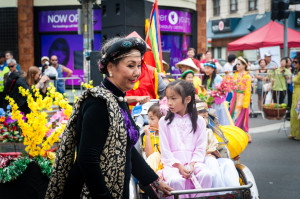40 years of Vietnamese cultural infusions

‘East meets West’ festival aims to recreate the colours seen on the streets of Saigon (Ho Chi Minh City) in Spring. ( ABC: Lili Tu)
Since those exiled arrived here from the conflict in Indochina, the Vietnamese have weaved their traditions through the colourful cultural tapestry of Australia.
After North Vietnam’s communist government take over of South Vietnam in 1975, Australia accepted tens of thousands of Vietnamese refugees including 2000 that arrived by boat.
Through tremendous hardship, those escaping Saigon made a home for themselves and their families have flourished.
In Victoria 70,000 Vietnamese-Australians reside in suburbs such as Richmond, Footscray, Springvale, Sunshine and St Albans.
One of these residents is mayor of Maribyrnong Cr Nam Quach, whose parents were a part of the thousands that escaped Saigon in the late seventies.
Quach views the 40 year anniversary as a chance to remember the suffering endured but also to celebrate the triumphs every Vietnamese-Australian has made.
“When you first arrive its haphazard. People are in isolation and face real difficulties with blending in and finding their feet,” Quach says of newly arrived immigrants.
“Through adversity people have banded together and built a really strong community which isn’t insular. It’s very inviting and it’s becoming a part of mainstream Australia.”
Maribyrnong has a large population of residents from all over the globe, which Quach believes strengthens the area.
“Multiculturalism is inherent in the community here. People respect each other and work in harmony really well together.”
Though the Australian born mayor understands how difficult it can be to find a harmonious home like Maribyrnong.
Quach says his parents’ journey to Australia is special to him but it’s not unique. His father was a soldier in the war and was fighting in the Allied Forces for a democratic Vietnam. At the end of the war he was captured and thrown into a “re-education camp” for four years. After his release he made plans to escape from Vietnam.
“Living under a communist regime went against everything he had fought for: the principles of liberty, freedom and democracy. He knew he wouldn’t be able to hold his tongue and live under such a regime,” says Quach.
Having naval experience, his father captained a ship carrying refugees to Malaysia. The journey was dangerous, they encountered pirates, and Quach’s mother was forced to give birth en route. Finally they reached their destination and upon being given a choice of various countries to settle in, they picked Australia.
“My parents never had the opportunity to get involved with the destiny of their country. For many people, particularly immigrants, democracy is just a hope and a dream. In Australia, our government is empowered by its people.”
The mayor has taken advantage of the opportunities his parents were denied by becoming involved in his government, a necessary achievement to ensure Vietnamese people are proportionately represented.
Vietnam is the fifth-largest source of immigration to Australia in terms of birthplace and the community is widely viewed as an example of ideal integration into mainstream society.
The Vietnamese’s impact as a model of integration and their large population means representatives of the community have a vital role in decision making for Australia.
Born in Vietnam, South Australian governor Hieu Van Le is both an important representative and Saigon survivor.
Le is one of the many higher achievers from the Vietnamese community, being a noted economist that previously had a senior position with the Australian Securities and Investments Commission.
After the fall of Saigon, Le’s two brothers who had served in the army were forced into “re-education” camps. At the young age of 22, Le knew he and his wife Lan needed to flee so began the treacherous journey in a small boat bound for Australia.
The governor now often tells the story of his arrival to our shores.
“Out of this curtain of mist we saw the little tinnie coming toward us, quite fast, and there were two blokes standing in it, shorts and singlets, sunhats on, white zinc cream on their noses, the fishing rod sticking up into the sky,” the governor reminisces.
“They waved at us and they come very close, very close and very fast to our boat and one of them raised the stubbie up as if proposing a toast.”
“’G’day, mate!’ he shouted. “Welcome to Australia.”
40 years after that cheerful welcome the Vietnamese culture has enriched Australia’s own. Now, with over 200,000 Australians that claim Vietnamese ancestry, it’s a vital part of our nation’s identity.
Ruby Brown
AMES Staff Writer












